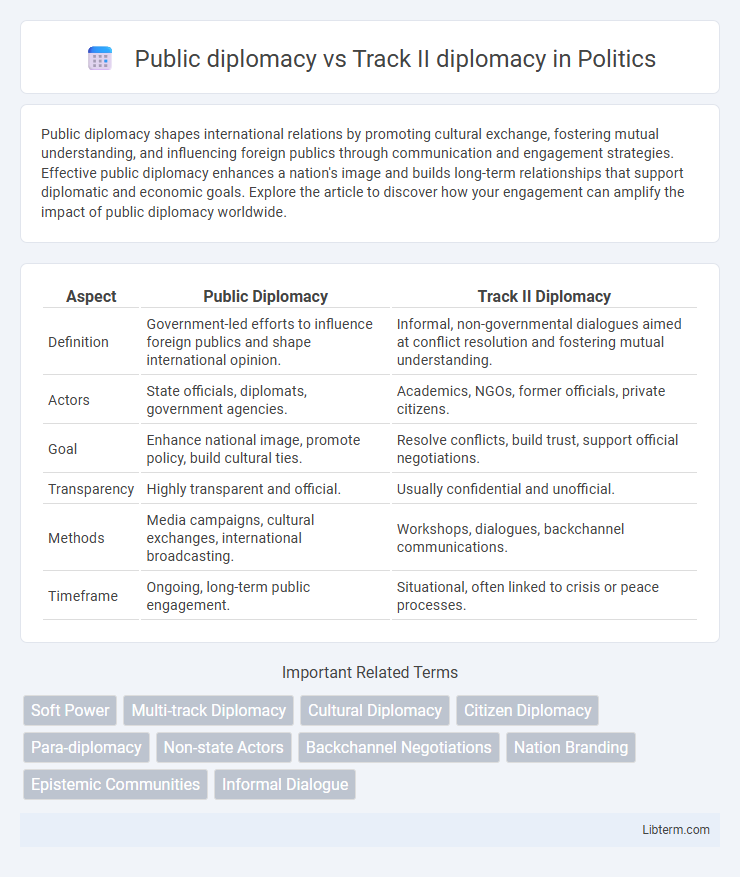Public diplomacy shapes international relations by promoting cultural exchange, fostering mutual understanding, and influencing foreign publics through communication and engagement strategies. Effective public diplomacy enhances a nation's image and builds long-term relationships that support diplomatic and economic goals. Explore the article to discover how your engagement can amplify the impact of public diplomacy worldwide.
Table of Comparison
| Aspect | Public Diplomacy | Track II Diplomacy |
|---|---|---|
| Definition | Government-led efforts to influence foreign publics and shape international opinion. | Informal, non-governmental dialogues aimed at conflict resolution and fostering mutual understanding. |
| Actors | State officials, diplomats, government agencies. | Academics, NGOs, former officials, private citizens. |
| Goal | Enhance national image, promote policy, build cultural ties. | Resolve conflicts, build trust, support official negotiations. |
| Transparency | Highly transparent and official. | Usually confidential and unofficial. |
| Methods | Media campaigns, cultural exchanges, international broadcasting. | Workshops, dialogues, backchannel communications. |
| Timeframe | Ongoing, long-term public engagement. | Situational, often linked to crisis or peace processes. |
Introduction to Public Diplomacy and Track II Diplomacy
Public diplomacy involves government-led efforts to influence foreign publics and shape international perceptions through communication, cultural exchanges, and media outreach. Track II diplomacy consists of informal, non-governmental dialogues and problem-solving activities conducted by academics, former officials, and civil society actors aimed at complementing official diplomatic efforts. Both approaches play crucial roles in building trust and understanding between nations outside traditional state-to-state negotiations.
Defining Public Diplomacy
Public diplomacy involves government-led efforts to influence foreign publics and shape international public opinion through communication, cultural exchanges, and media engagement. It aims to promote national interests by fostering mutual understanding and goodwill between countries. In contrast, Track II diplomacy refers to informal, non-governmental dialogues and negotiations conducted by private individuals or organizations to build trust and resolve conflicts outside official diplomatic channels.
Understanding Track II Diplomacy
Track II diplomacy involves informal, non-governmental interactions between private citizens, academics, and non-state actors aimed at resolving conflicts and building mutual understanding beyond official government channels. This approach fosters open dialogue, trust-building, and creative problem-solving, often laying the groundwork for formal negotiations characteristic of public diplomacy. Understanding Track II diplomacy is crucial for leveraging its potential to complement official diplomatic efforts by addressing sensitive issues in a less constrained environment.
Historical Evolution of Public and Track II Diplomacy
Public diplomacy emerged prominently during the Cold War as governments sought to influence foreign public opinion and promote national interests through cultural exchanges, broadcasting, and international communication. Track II diplomacy originated in the mid-20th century as unofficial dialogue channels involving non-governmental actors to resolve conflicts and complement formal negotiations. Both forms evolved alongside shifts in global power dynamics, with public diplomacy expanding in the digital age and Track II diplomacy gaining importance in addressing complex international disputes.
Key Differences Between Public and Track II Diplomacy
Public diplomacy involves official government efforts to influence foreign publics through communication, cultural exchanges, and media outreach, aiming to shape a country's image and policy support globally. Track II diplomacy consists of informal, non-governmental dialogues and problem-solving activities between private citizens, academics, and former officials that complement official diplomacy by building trust and exploring solutions outside formal channels. Key differences lie in their actors--government-led versus unofficial participants--and their methods, with public diplomacy focusing on mass communication and Track II emphasizing confidential, interactive discussions.
Common Objectives and Overlapping Areas
Public diplomacy and Track II diplomacy both aim to improve international relations by fostering mutual understanding, trust, and collaboration across cultural and political boundaries. Common objectives include promoting dialogue on contentious issues, supporting conflict resolution, and enhancing national image through people-to-people connections. Overlapping areas involve engaging non-state actors, civil society organizations, and influential individuals to complement official government efforts in shaping foreign policy and public opinion.
Strengths and Weaknesses of Each Approach
Public diplomacy leverages government resources to influence foreign publics through official channels, enhancing legitimacy and broad reach but often facing skepticism due to perceived state bias. Track II diplomacy operates through informal, non-governmental dialogue, fostering trust and innovative solutions without official constraints but lacking enforcement power and direct policy impact. Both approaches complement each other by combining official authority with grassroots engagement, though their effectiveness varies based on context and stakeholder willingness.
Case Studies: Public vs. Track II Diplomacy in Action
Public diplomacy leverages official government channels to influence foreign publics through communication strategies and cultural exchanges, as demonstrated in the U.S. government's engagement with Chinese citizens during the 2008 Beijing Olympics. Track II diplomacy operates through informal, non-governmental dialogues like the Norwegian-led secret negotiations between Israel and the Palestine Liberation Organization (PLO) in the 1990s, facilitating conflict resolution without direct governmental involvement. Comparing these approaches highlights that public diplomacy shapes public perception and national image globally, while Track II diplomacy enables confidential problem-solving and trust-building in highly sensitive political conflicts.
Synergies and Opportunities for Collaboration
Public diplomacy and Track II diplomacy offer complementary strategies for international engagement by blending official government efforts with informal, private sector dialogues to strengthen bilateral relations. Public diplomacy leverages media, cultural exchanges, and strategic communication to influence foreign public opinions, while Track II diplomacy fosters behind-the-scenes negotiations involving academics, NGOs, and civil society to resolve conflicts and build trust. Collaboration between these approaches enhances conflict resolution, promotes mutual understanding, and expands the scope of diplomatic impact through coordinated messaging and inclusive stakeholder involvement.
Future Trends in Diplomatic Engagement
Emerging trends in diplomatic engagement emphasize the integration of public diplomacy and Track II diplomacy, leveraging digital platforms and social media to amplify influence and foster dialogue. Future diplomatic strategies prioritize inclusive, multi-stakeholder frameworks that combine official government channels with informal, non-governmental actors to address complex global challenges. The convergence of these approaches enhances transparency, builds trust, and supports sustainable conflict resolution in an increasingly interconnected world.
Public diplomacy Infographic

 libterm.com
libterm.com